NJFSC Chapter #44S..........PHS Affiliate #1A..........APS Affiliate #95 |
Society & Member's Galleries....
As we continue to add more galleries, some will be for public display while many will be reserved for members access only.
Featured Covers Gallery
November 2013 Issue of the NJPH Journal JERSEY CITY AND THE BEGINNING OF BIG TOBACCO
By John A. Trosky
P. Lorillard & Company, one of the most iconic names in the tobacco industry in
America, had its beginnings in the New York City area in the mid 17th century. The company
was founded by Pierre Abraham Lorillard, a French Huguenot, in the year 1760. Its small
beginnings were from a rented home on Chatham Street, now Park Row, in lower Manhattan.
The company began as a snuff grinding factory. Lorillard is recognized as the first man to make
snuff in America. He single handedly made New York a destination for world class tobacco
products. One of his first business secrets was to sell his tobacco in dried animal bladders to
maintain freshness, a bit repulsive today. His trademark of an Indian standing next to a hogshead
of tobacco soon became one of the most recognized trademarks around the globe. Still in
business today, they are the oldest continuously operated tobacco company in the world.
They
recently celebrated their 250th anniversary in 2010 making them the oldest publicly traded
company in the United States. With success, the fledgling company moved to newer quarters in
what is now the Bronx, along the Bronx River. It is here where a snuff mill was constructed on
land purchased by Pierre Lorillard and what today, is now, the grounds of the New York
Botanical Garden.
|
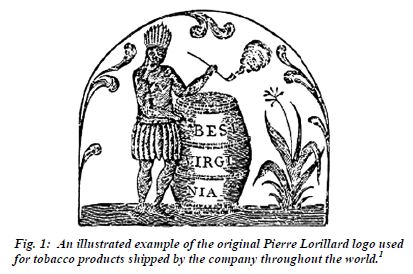
|
Although some may recognize the name Lorillard, few may realize that the purveyor of
such well known brands as Kent, Old Gold, Newport and Beech Nut, among their 160 brands,
had a distinct connection to New Jersey and Jersey City in particular. Pierre Lorillard maintained
a successful tobacco business in New York City until 1776 when he was killed by Hessian
mercenaries of the British during their occupation of New York. Upon the death of Pierre, his
sons, George and Peter (Pierre II) took over the business and continued to grow it. The popularity
of tobacco in 18th and 19th century America insured that profits would soar and the company
would see continued growth.
|
In the early 1870s, having outgrown their facility in the Bronx, the Lorillard family chose
to move their manufacturing to a new location on the other side of the Hudson River in Jersey
City, New Jersey. It was on the site of 111 First Street in Jersey City that they took over a plant
that was constructed by one of the nation’s first conglomerates, the American Screw Company. It
was a Greek revival red brick building that fronted on Washington Street that they would use to
manufacture tobacco products and snuff. This factory became a part of a fast growing
manufacturing area along the downtown Jersey City waterfront. The location provided easy
access to rail and water transportation to ship products worldwide.
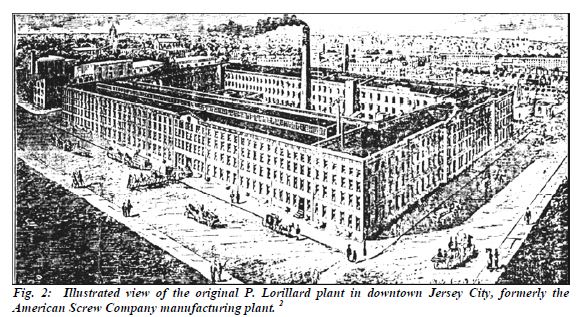
The soon-to-be Mayor of Jersey City, Charles Seidler, would eventually become a partner
in this venture with the Lorillards. Some even say that it was Seidler, himself, who convinced the
Lorillards to move their business to Jersey City in the first place. The potential benefits of the
location were Harsimus Yards and the nearby Pennsylvania Railroad for product distribution, a
large newly arrived immigrant population for cheap labor, close proximity to a port for the
shipping of product and the importation of spices for flavoring different brands of tobacco, and a
readily available municipal waste system. Since their chief product was of a highly combustible
nature, Lorillard was very concerned about fire safety. They were one of the first firms to install
a rudimentary automatic sprinkler system through their building and they also maintained a detail
of firefighters.
The three brick factory buildings occupied sixty-six city lots. They also had an additional
eighteen city lots for making wooden cases for packing and transporting goods. There were
upwards of 3500 people working in the factory at any given time, drawing a payroll of $35,000
per week. By 1884 the number of employees had risen to over 4000, with many of those workers
under-aged boys and girls. With no child labor laws in existence in the 19th century and Jersey
City unwilling or unable to provide free night school, it was the P. Lorillard Company that took it
upon itself in 1884 to comply with New Jersey’s compulsory school laws by forming its own
evening school for workers under the age of sixteen. The school was situated near the factory on
Newark Avenue in Booraem Hall. |
A local physician, Dr. Leonard Gordon, was Lorillard’s chief chemist who also managed a
free library for all adult employees at the plant. Dr. Gordon would go on to become a director of
the Jersey City Free Public Library. Lorillard also provided a dispensary to all employees as well
as sewing classes.
The company continued to grow in the late 19th century and a new annex was built
between 1st and 2nd Streets in Jersey City. Although all manufacturing was done in Jersey City,
the company maintained a corporate presence in New York City at 114 Water Street.
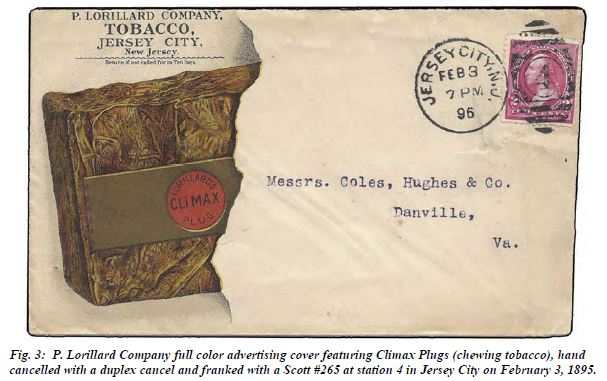
Great success also brought great wealth to the Lorillard family. They used much of that
wealth to construct lavish homes. The family owned country property in downstate New York
which would become Tuxedo Park in the 1880s. It was here that Pierre Lorillard IV would arrive
at a formal ball at the Tuxedo Club in 1886 in a new style of formal wear that he had designed
himself. He named his new creation in honor of the town and thus, the tuxedo was born.
With the dawn of the 20th century things began to change for the Lorillard empire. James
Buchanan Duke, founder of the American Tobacco Company, soon absorbed the Lorillard firm in
1910. Duke had the license for a cigarette rolling machine that changed the dynamics of the
industry. Although a part of the American Tobacco company conglomerate, Lorillard was
allowed to keep its name intact. A new factory was constructed in Jersey City on the old
Thompson estate in the Marion section of the city on 170 city lots and employing 5000 workers.
The factory was of brick and steel construction and was located close to the Pennsylvania, the
Lackawanna, the Erie and the Susquehanna railroads.
|
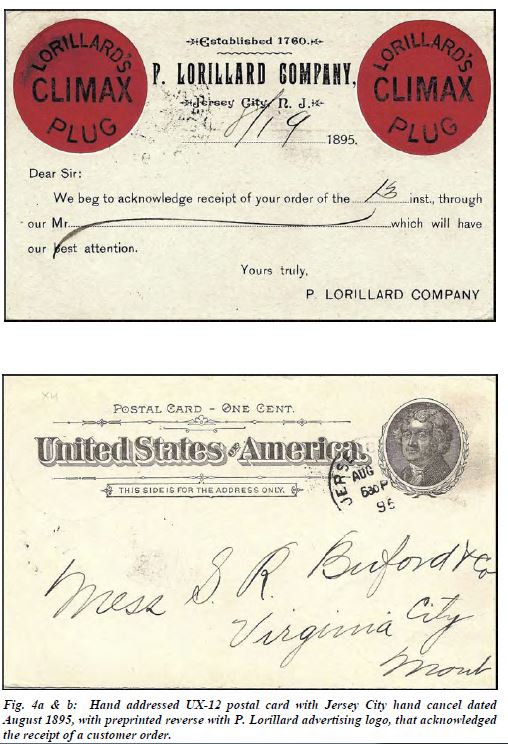 |
Lorillard was once again an independent company after the US Supreme Court ruled
against the American Tobacco Company in an anti-trust action in 1911. The original factory at
111 First Street continued to manufacture “plugs” until 1919 and the cigar factory located at 104
First Street continued in operation until 1928, the latter being destroyed by fire in 1990. Lorillard
eventually moved all of its manufacturing operations out of Jersey City in 1956 to Greensboro,
NC. The main Lorillard facility was taken over by rival R.J. Reynolds, the manufacturer of “Camel” cigarettes in 1928.
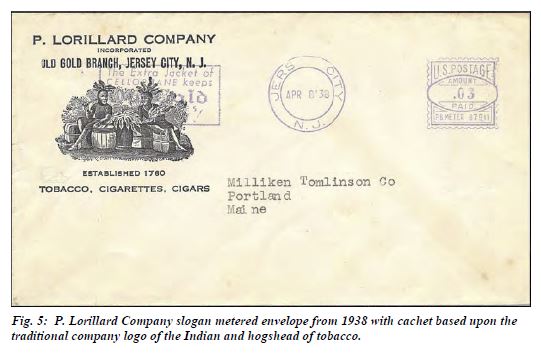
A variety of businesses occupied the 111 First Street site over the years, including light
manufacturing, retail and storage companies. The facility showed promise as an arts center
offering cheap spaces to artists for studios, galleries and loft space. Unfortunately, with the
advance of the real estate boom in the downtown area of Jersey City, and what has become
known as “Wall Street West,” this last vestige of the Lorillard empire in Jersey City was razed in
2007 after a long legal battle, to make way for a luxury condo tower. Other Lorillard sites in
Jersey City were also razed over the years so that nothing remains of the once mighty presence of
this tobacco giant.
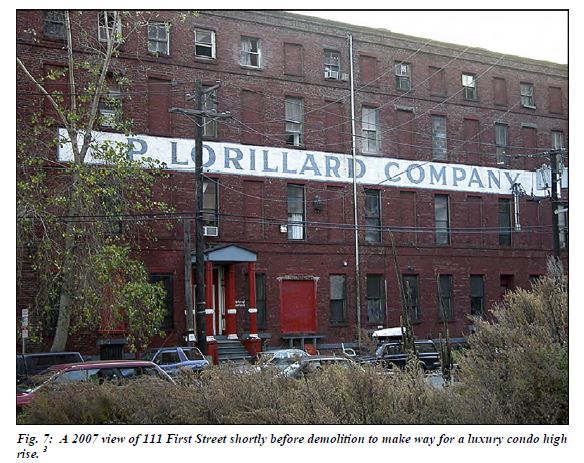
|
Past Featured Covers
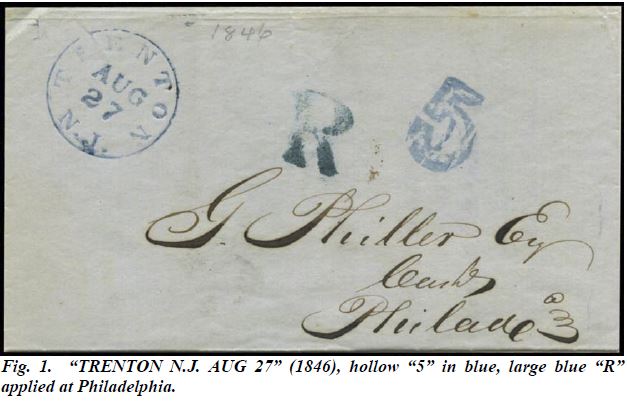 |
August 2013 Issue of the NJPH Journal UNOFFICIAL REGISTRATION OF NEW JERSEY STAMPLESS COVERS By James W. Milgram, M.D.
From November 1, 1845 to June 30, 1855 there was an unofficial type of Registration of
valuable letters at most post offices within the United States. The first marking is the large blue
“R” applied on receipt at Philadelphia beginning in 1845 Read more.....
|
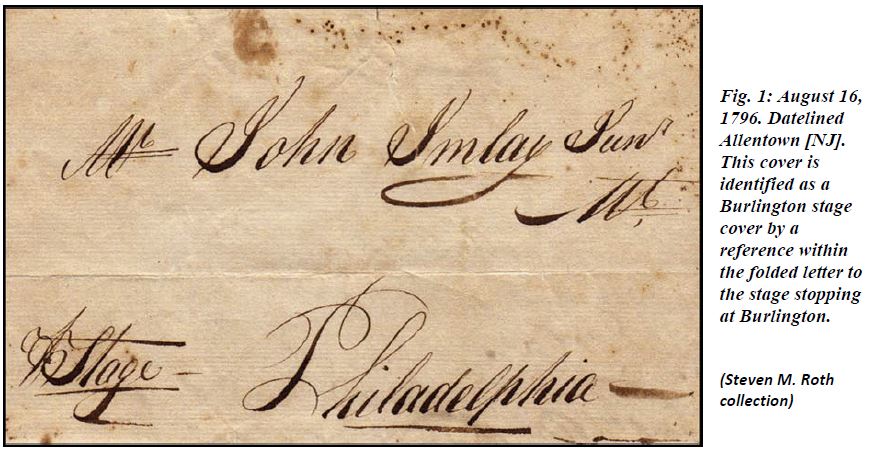 |
May 2013 Issue of the NJPH JournalSTAGE OPERATIONS AND THE MAILS IN NEW JERSEY©
By Steven M. Roth (© 2013. Steven M. Roth)
Prior to the Revolutionary War, major travel in the American colonies was restricted
for the most part to the Read more..... |
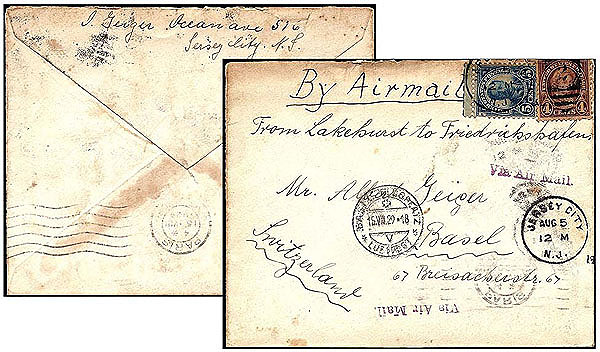 |
February 2013 Issue of the NJPH Journal INTENDED FOR THE GRAF ZEPPELIN BUT CARRIED BY STEAMER? A 1929 Jersey City Transatlantic Airmail to Basel Switzerland
by John Trosky
The first decades of the 20th century saw the dawn of a new age in mail transport, airmail. By
the late 1920s Read more..... |
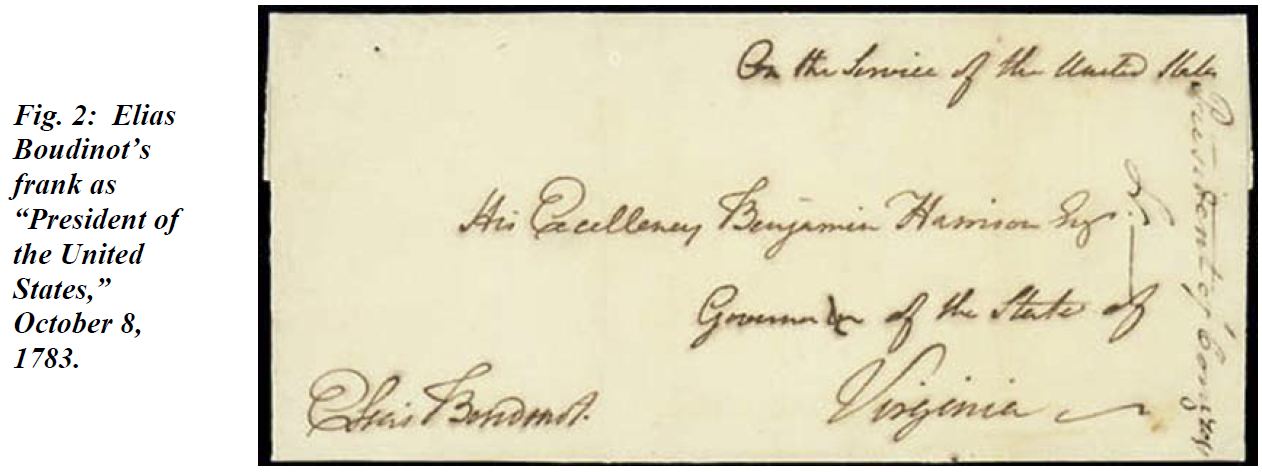 |
November 2012 Issue of the NJPH Journal LEGISLATIVE FRANKS OF NEW JERSEY by Ed & Jean Siskin
The franking privilege is the right to send and or receive mail free from postage.
Read more..... |
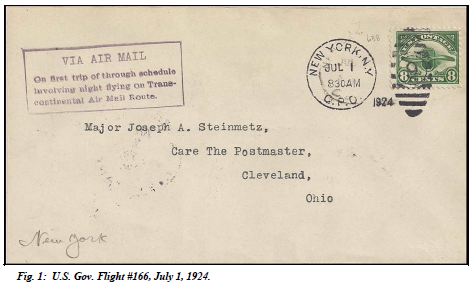 |
August 2012 Issue of the NJPH Journal HADLEY AIR FIELD, NEW BRUNSWICK. NEW JERSEY by Jim Walker
Early air mail service in the New York area used an assortment of air fields on Long
Island. Hazlehurst Field was the one in use at the commencement of Transcontinental Air Mail
Service in 1924 and was deemed inadequate due to smoke from city industries and ocean fog.
Read more..... |
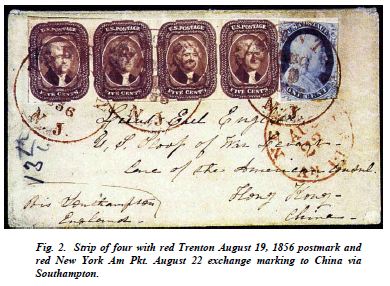 |
May 2012 Issue of the NJPH Journal FIVE CENT 1856 STAMP ON COVERS FROM NEW JERSEY by Robert G. Rose
Have you ever fantasized, as have I, of forming a collection of United States
classic stamps used on covers from New Jersey? If so, the task to put such a collection
together would be a real challenge....
Read more..... |
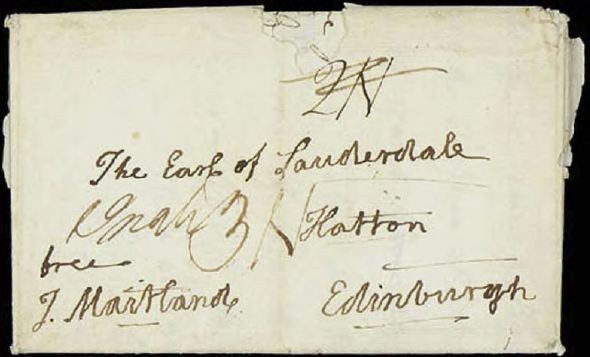 |
February 2012 Issue of the NJPH Journal A Wonderful Revolutionary Letter by Ed and Jean Sisken
In the Oct-Nov 1988 issue of La Posta, Tom Clarke wrote an article about a wonderful
Revolutionary War cover he had. Dated February 16, 1777, from New Brunswick, New Jersey...
Read more..... |
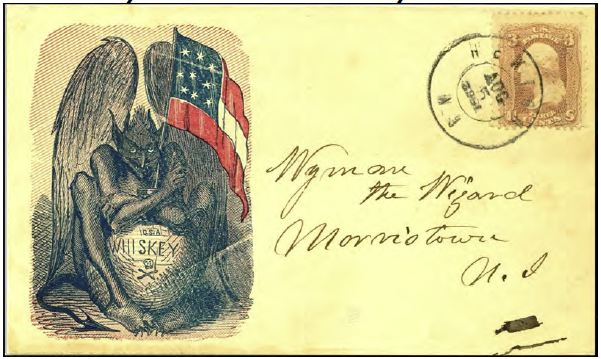 |
November 2011 Issue of the NJPH Journal New Jersey Civil War Covers -Wyman the Wizard!
If you were to conduct a detailed review of the 190 Civil War
patriotic covers illustrated in NJPH whole nos. issues 100 and 117, or the
online exhibit of covers shown at NOJEX, you can begin to see the
emergence of some interesting patterns among the covers. An obvious
pattern is that there are several different correspondences represented in
the illustrated covers. Read more..... |
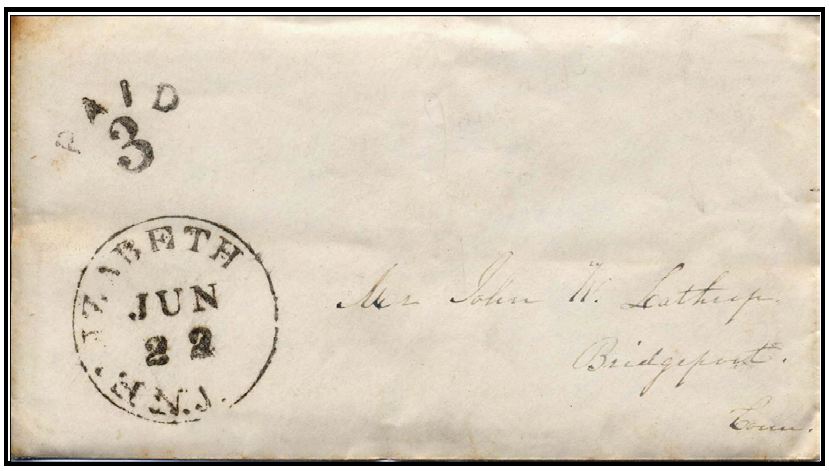 |
August 2011 Issue of the NJPH Journal New Elizabeth, NJ Marking
ELIZABETHTOWN STAMPLESS POSTMARK ALTERED TO READ “ELIZABETH”!
This newly-discovered Elizabeth postmark falls at the time the name was changed from
Elizabethtown to Elizabeth, and a new handstamp was created from an existing Elizabeth-town
postmark.
Read more..... |
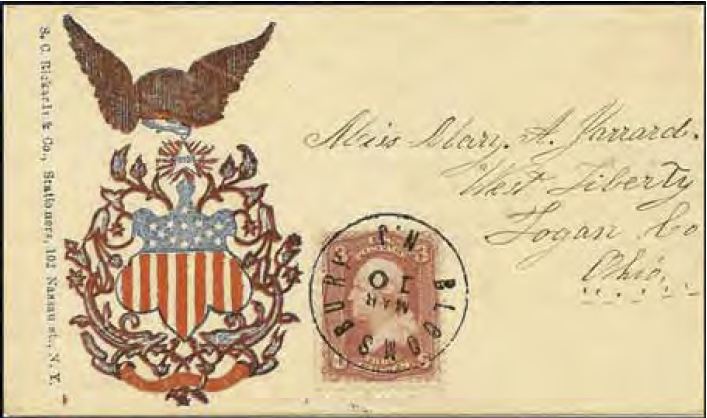 |
May 2011 Issue of the NJPH Journal Civil War Patriotic Covers from New Jersey.
The cover below is dated Mar. 10 from Bloomsbury, NJ to West Liberty, Ohio, with the imprint of S.C. Rickards, Stationers, 102 Nassau Street, N.Y., and shows one of the rare New Jersey Civil War patriotic images.
Read more..... |
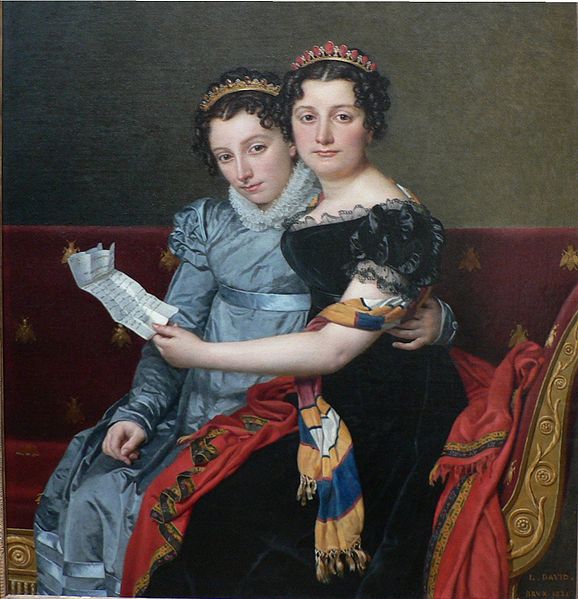 |
February 2011 Issue of the NJPH Journal A Folded Letter in art - was it from New Jersey?
This painting by Jacques-Louis David, painted in 1821, shows two Bonaparte princesses reading a stampless folded letter from their father, Joseph Bonaparte, brother of Napoleon. Was it written to them from New Jersey?
Read more..... |
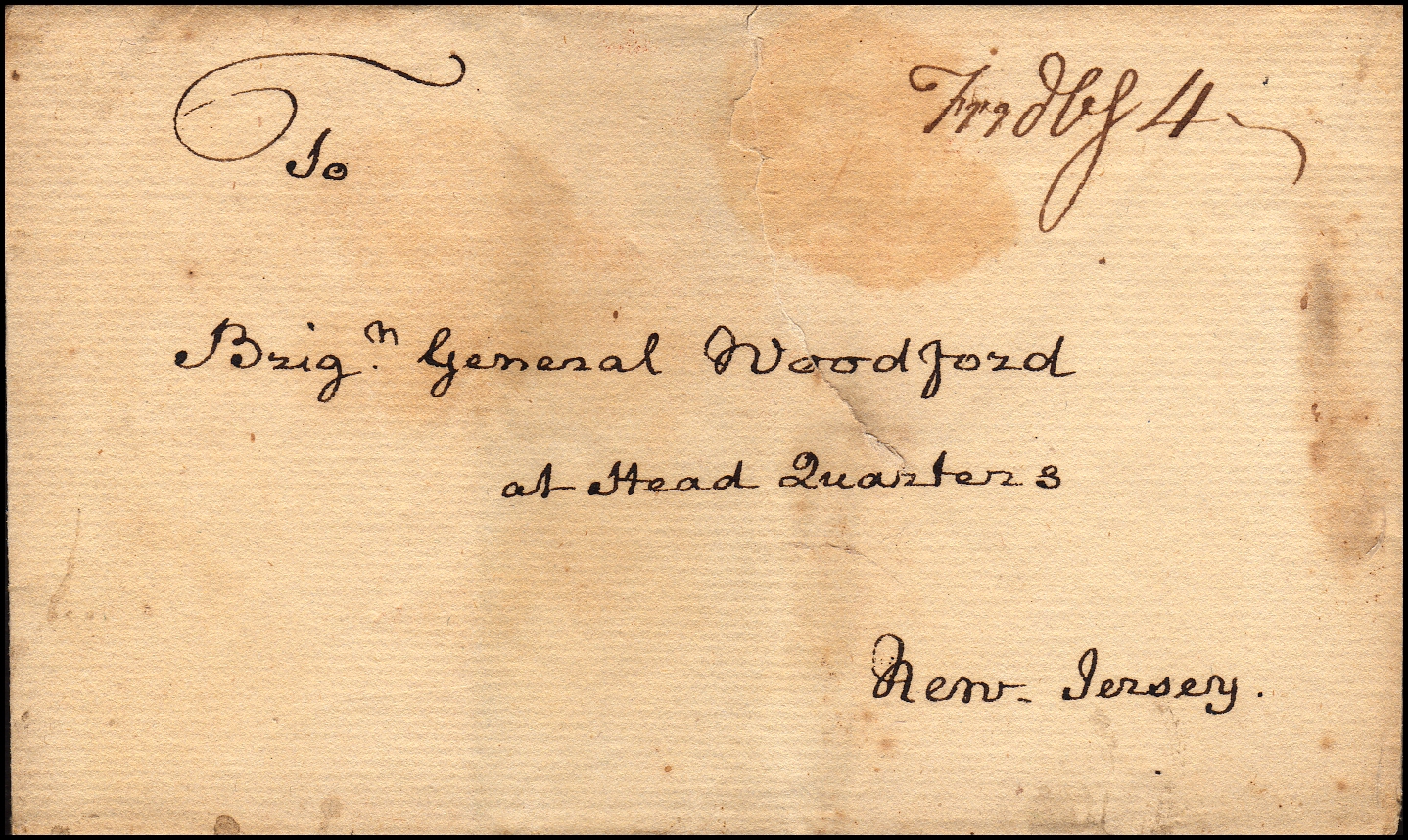 |
November 2010 Issue of the NJPH Journal REVOLUTIONARY WAR COVER
The cover of our most recent journal features this Revolutionary item, from Don Chafetz’s prize-winning exhibit of Morris County Mail Service, 1760 to 1850.
Read more..... |
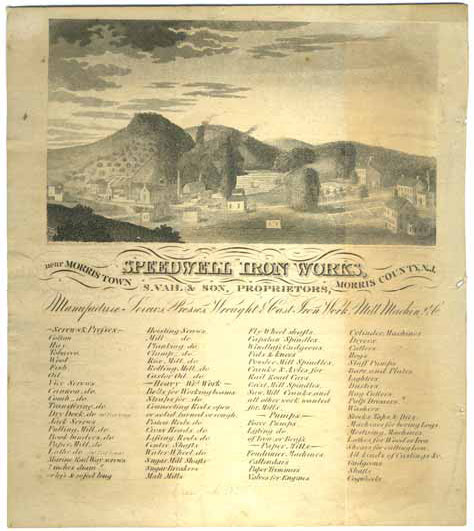 |
August 2010 Issue of the NJPH Journal NEW JERSEY ILLUSTRATED LETTER SHEETS
These items were made popular by the nice ones that exist from the California Gold Rush days, and those used during the Civil War, where they depicted contemporary scenes at the top of the letter sheet, the rest of which was then used to write a letter.
Earliest examples usually included an attached sheet and were used as stampless folded letters.
Later ones were more like letterheads, and were sent enclosed in envelopes.
Read more..... |
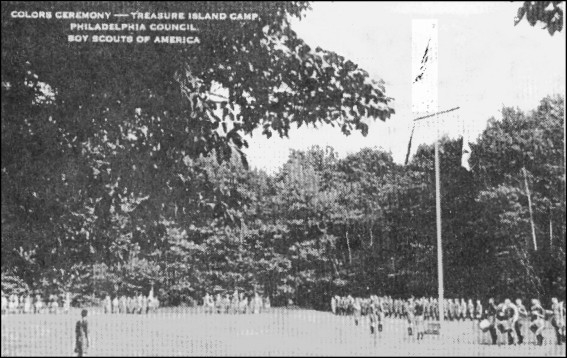 |
May 2010 Issue of the NJPH Journal Celebrates the 100th Anniversary of the Boy Scouts of America!
Treasure Island Scout Camp occupies a fifty-seven acre island in the Delaware River between Pennsylvania and New Jersey. The camp is operated by the Cradle of Liberty Council (formerly the Philadelphia Council), Boy Scouts of America. Read more..... |
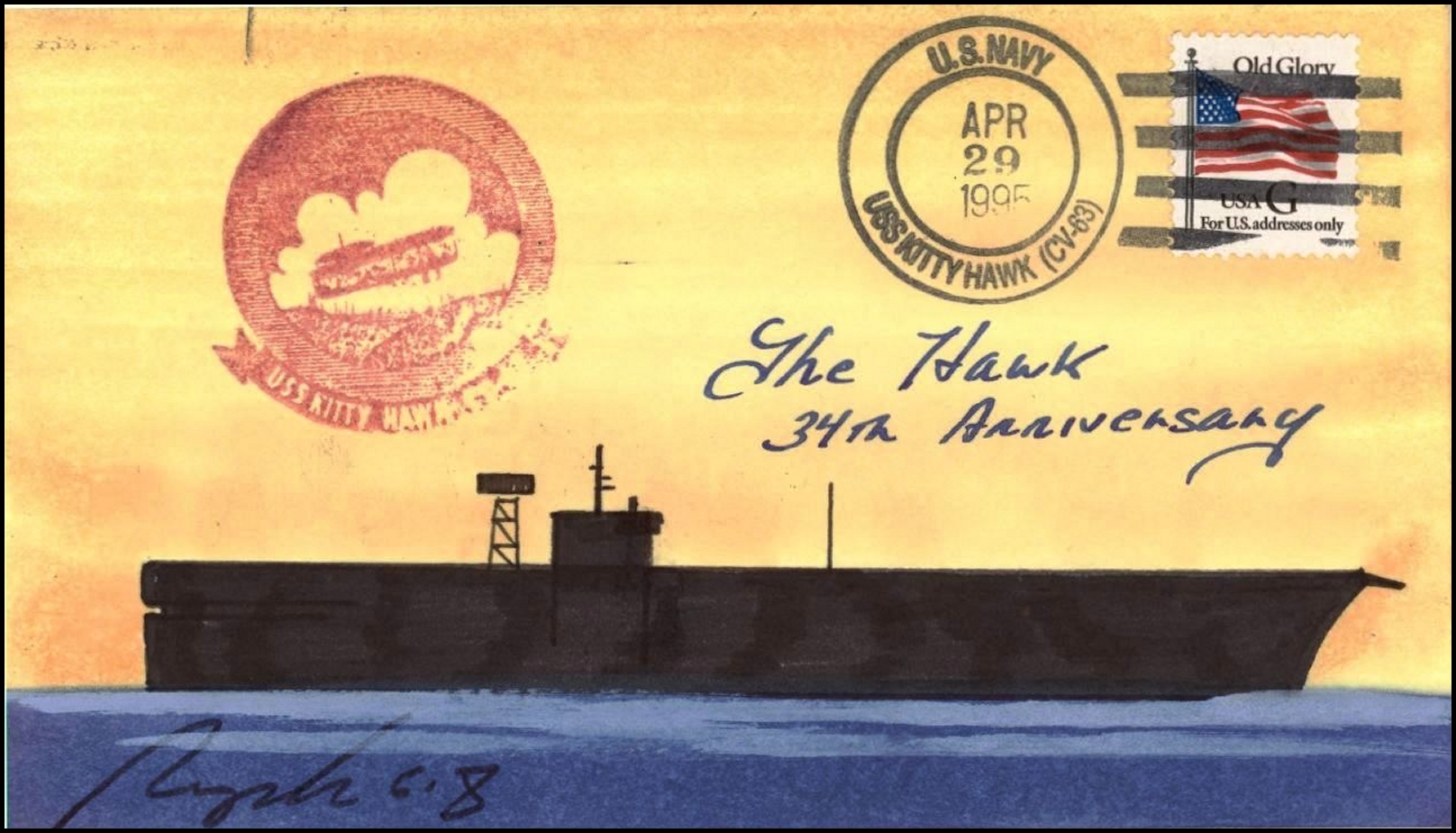 |
February 2010 Issue of the NJPH Journal featuring a 1995 cover of the aircraft carrier USS Kitty Hawk, the last of the conventionally-powered US aircraft carriers, decommissioned in 2009.
This great ship served almost 50 years in service of her country.
Read more..... |
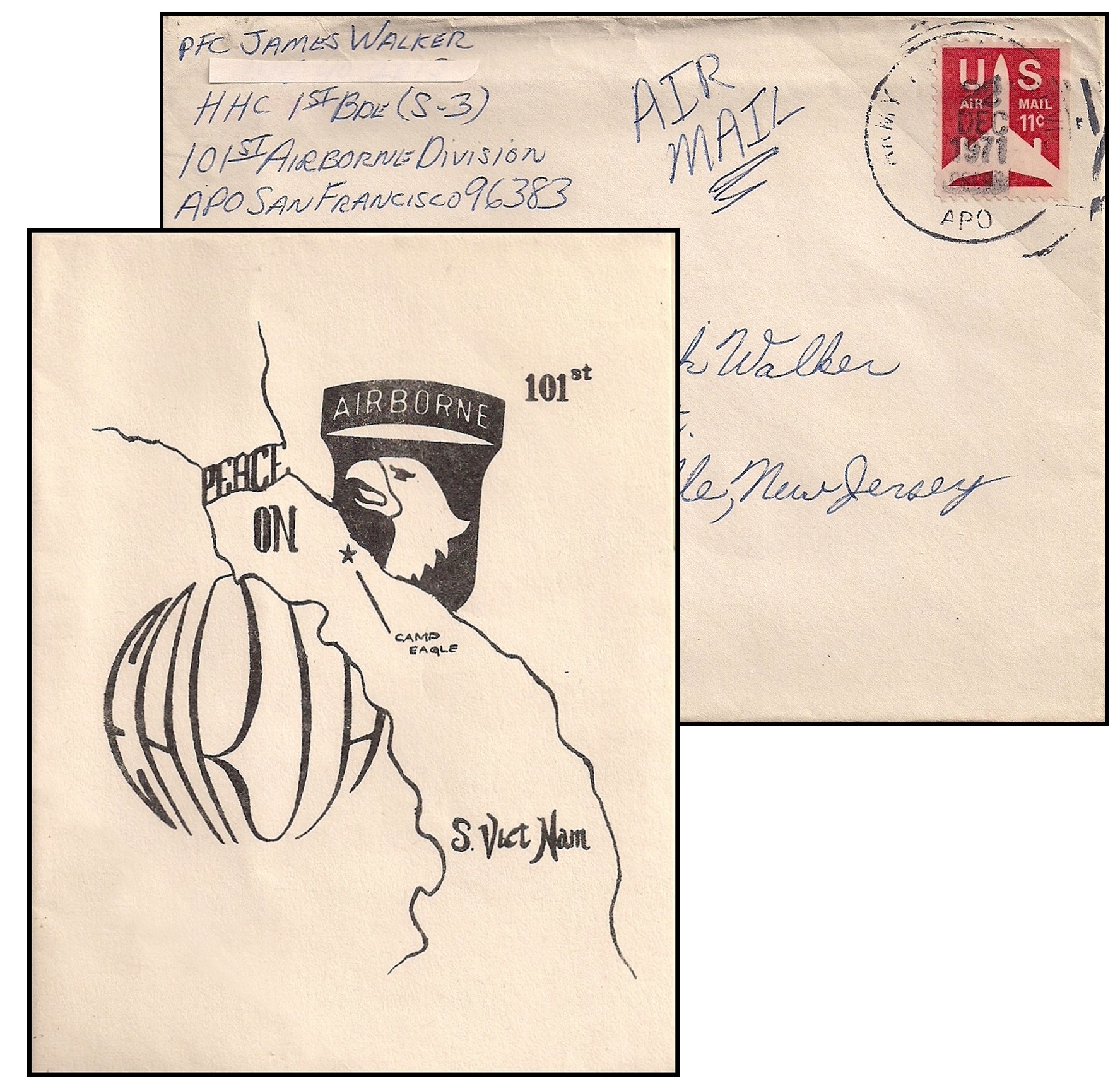 |
November 2009 Issue of the NJPH Journal featuring a Holiday Greetings from Viet Nam
Just before Christmas of 1971, a GI-produced Christmas card was distributed to the troops of the 101st Airborne for them to send home. A hand-made envelope served to carry it home to New Jersey.
As it was late in December, member Jim Walker used a U.S. air mail stamp instead of the usual free frank available to soldiers in combat,
Read more..... |
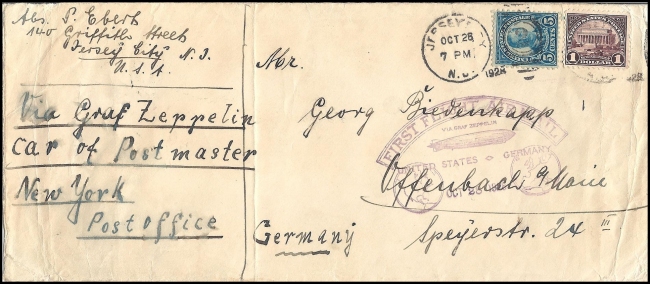 |
August 2009 Issue of the NJPH Journal featuring a a Graf Zeppelin cover.
L127 First Trip to the USA in 1928. Special credit to John Trosky for this nice article!
WEB-SITE SPECIAL: an addendum to this article with additional information on an originating 1928 LZ-127 cover from Len Peck!
Read more..... |
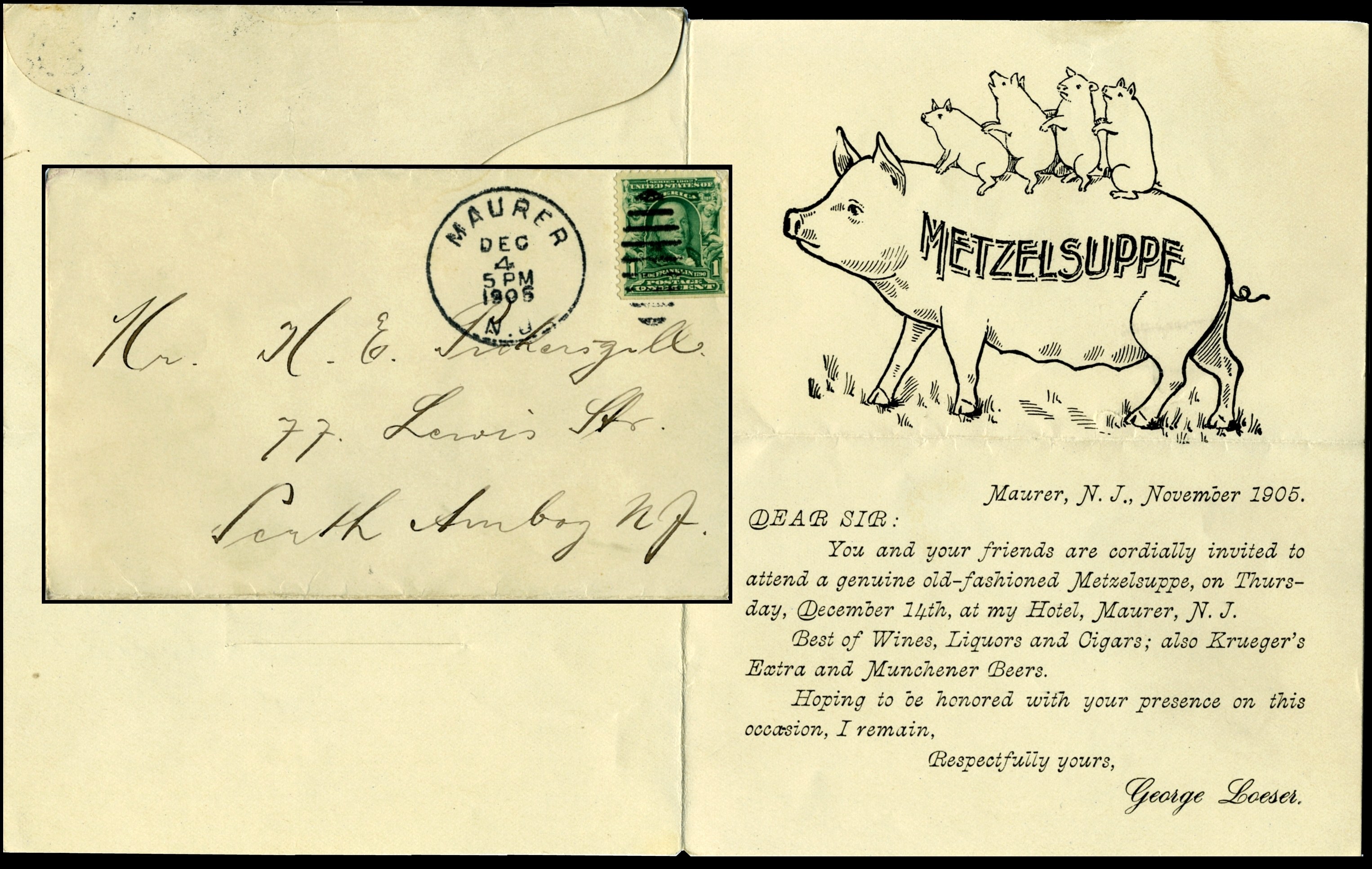 |
May 2009 Issue of the NJPH Journal featuring a DPO cover from Maurer, New Jersey.
A pretty little letter sheet invitation from a local hotel in Maurer (now part of Perth Amboy, Middlesex County), NJ turned up at the Garfield-Perry Show in Cleveland, in JWF (Jim Faber’s) stock. Used in 1905, it is from a community that literally does not exist anymore. The location is now the site of a large “tank farm” belonging to Chevron.Read more..... |
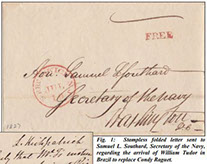 |
February 2009 Issue of the NJPH Journal featuring a cameo campaign cover.
A December 15, Hoboken, NJ postmarked Embossed Cameo Campaign Envelope produced by William Eaves was offered this March by Robert A. Siegel Auctions featuring a beardless Abe Lincoln. Only a few examples are known. This Hoboken, New Jersey cover hammered on March 25, 2009 for $2600.00 before the 15% buyers premium! Read more..... |
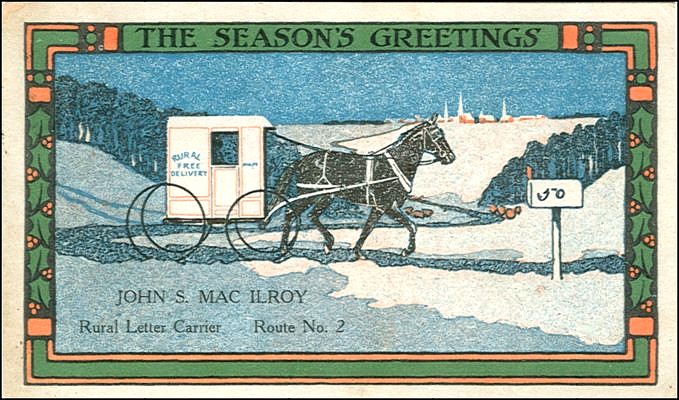 |
November 2008 Issue of the NJPH Journal featuring a cover of seasonal greeting.
A RFD ”Season’s Greetings” post card, cancelled December 24, 1915 with a Pittstown, NJ postmark, sent by the carrier on Route 2 out of Pittstown to the people along his route. Special thanks to Member Jim Walker for sharing this cover. Read more..... |
Members: One of the benefits of membership is sharing your interests and collections! If you would like to share an interesting single item from your collection, or have multiple items to share - the NJPHS Galleries offer you the opportunity to put your collectibles on center stage. Please e-mail your webmaster about contributing to our on-line Galleries. We can even help you if you do not have a scanner or digital images. Just ask. Remember, we are always looking for articles of interest for the NJPH Journal, and would welcome your contribution whether it's a single page or five page article.
If you are not yet a member, please consider the benefits of joining and the satisfaction you'll get by sharing with your fellow collectors: Become a Member |
